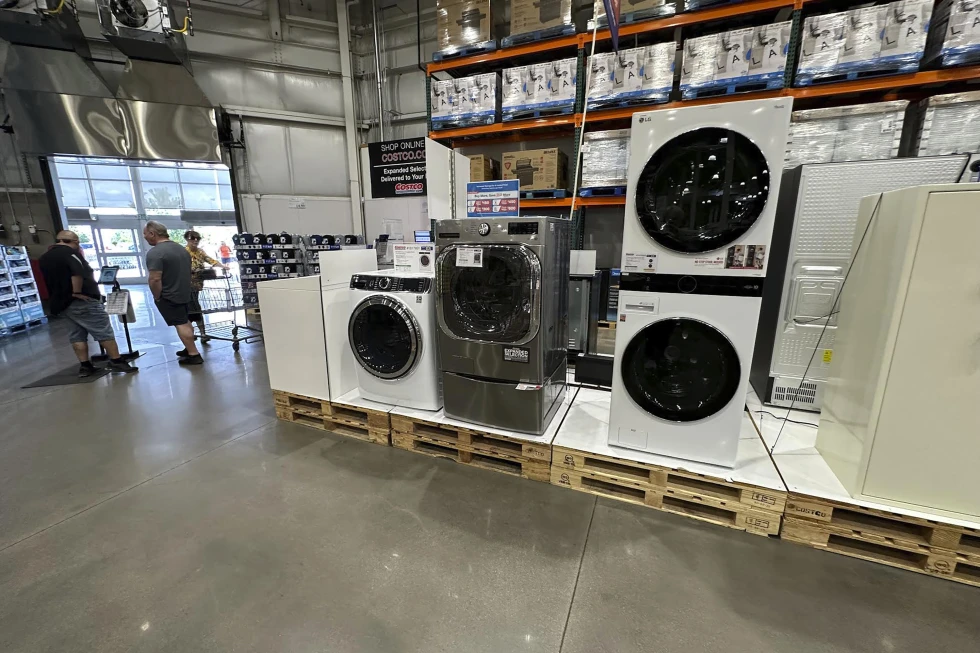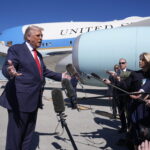Trump Tariffs Drive Inflation Higher, Fed Holds Rates/ Newslooks/ WASHINGTON/ J. Mansour/ Morning Edition/ U.S. inflation ticked up in June, driven in part by price hikes on imported goods due to President Trump’s sweeping tariffs. The Federal Reserve’s preferred inflation measure rose 2.6% annually, above the central bank’s target. Despite pressure from Trump, the Fed held interest rates steady as economic uncertainty grows.

Inflation Gauge Rises Under Trump Tariffs: Quick Looks
- Fed’s key inflation index rose 2.6% in June
- Core inflation held at 2.8%, still above Fed target
- Prices rose 0.3% month-over-month, signaling upward pressure
- Trump’s tariffs credited with driving up imported goods prices
- Fed leaves interest rate at 4.3%, resists Trump pressure
- Consumer spending growth slowed to just 1.4%
- GDP grew 3% in Q2, boosted by sharp import drop
- Cost of items like furniture and appliances increased
Deep Look: Trump Tariffs Push Prices Higher as Fed Inflation Gauge Climbs
Inflation in the United States accelerated in June, reflecting growing pressure on consumer goods prices following President Donald Trump’s sweeping new tariff regime. According to data released Thursday by the Commerce Department, the Federal Reserve’s preferred inflation gauge—the Personal Consumption Expenditures (PCE) index—rose 2.6% year-over-year, up from 2.4% in May.
The monthly increase was also notable. Prices ticked up 0.3% from May to June, a sharper rise than economists had forecast and higher than levels considered consistent with the Fed’s 2% inflation target. When excluding volatile categories like food and energy, core inflation remained elevated at 2.8%, matching the prior month’s revised figure.
The price gains are being closely linked to President Trump’s wide-ranging tariffs on imported goods, which began taking effect earlier this year and have been expanded steadily. Items such as appliances, furniture, and toys, many of which are heavily imported, have seen significant price increases—costs that are now being passed along to consumers.
Fed Holds Rate as Inflation Persists
Despite mounting political pressure from President Trump to slash interest rates, the Federal Reserve held its benchmark rate steady at 4.3% during its policy meeting on Wednesday. Fed Chair Jerome Powell said that it remains too soon to tell whether the inflation uptick is a temporary reaction to import duties or a longer-term trend requiring more aggressive monetary policy.
“It may take several months before we understand the full impact of the tariffs,” Powell said during a press briefing.
The Fed’s caution stands in contrast to the Trump administration’s public frustration. The president has repeatedly criticized the central bank for not lowering borrowing costs more quickly in the face of rising economic headwinds and slowing consumer activity.
Economic Growth Shows Mixed Signals
Also on Wednesday, the government reported that the U.S. economy grew at a 3% annual rate in the second quarter, an improvement over Q1 figures and a sign of resilience amid ongoing trade disruptions. However, a closer look at the underlying data reveals potential cracks.
Consumer spending, which accounts for about two-thirds of U.S. economic activity, rose just 1.4% in Q2—up from a meager 0.5% in Q1 but still below expectations. In contrast, a sharp decline in imports contributed significantly to the GDP calculation, artificially boosting the headline growth rate.
That drop in imports was notable, especially given the surge in foreign goods in the first quarter as companies rushed to front-load inventory ahead of Trump’s new tariffs. The Q2 slowdown in trade activity, while statistically beneficial for GDP, may reflect deeper concerns about supply chain disruptions and weakening demand.
Trump Tariffs Shape Price Landscape
Earlier this month, the Labor Department reported that the Consumer Price Index (CPI)—the government’s most widely watched measure of inflation—also showed an increase in June. The rise was most prominent in product categories affected by Trump’s trade policies, such as home appliances, electronics, and toys.
Economists say these price increases are directly tied to the administration’s protectionist stance, which imposes double-digit tariffs on goods from a broad range of countries. While designed to bolster U.S. manufacturing, the approach has increased costs for retailers and consumers alike.
“We’re seeing clear evidence that trade policy is driving up consumer prices,” said Diane Swonk, chief economist at KPMG. “The question is whether that pressure becomes entrenched or fades after the initial shock.”
The impact has been particularly noticeable at the local level. At places like Deep Cuts Dallas Butcher Shop, food prices—while not included in the core inflation metric—have also shown volatility due to distribution costs affected by trade and fuel fluctuations.
What Comes Next for Inflation Policy
The latest inflation readings are likely to weigh heavily on the Fed’s next steps. While the central bank has been signaling caution, persistently elevated prices could force officials to keep rates higher for longer—even if growth starts to slow.
That would complicate the Trump administration’s economic messaging, particularly heading into an election cycle where the president has repeatedly touted tariffs as a solution to trade imbalances and job loss.
But for households, the policy mix is having a more immediate and tangible effect. Prices are rising, wage gains are slowing, and consumers are spending more conservatively—trends that could define the trajectory of the U.S. economy for the rest of the year.







